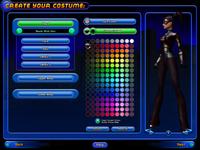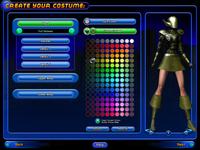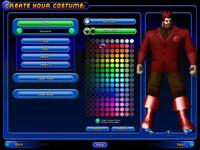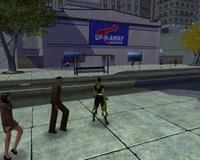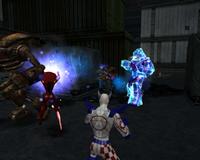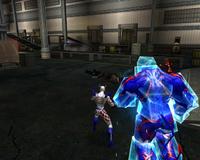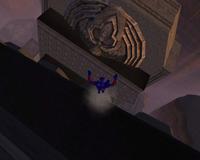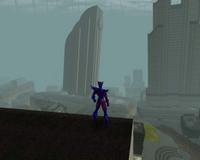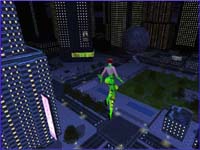|
|
|
Main News Forums Games Games Database Top 100 Release List Support Files Features Reviews Previews Interviews Editorials Diaries Misc Download Gallery Music Screenshots Videos Miscellaneous Staff Members Privacy Statement |
City of Heroes Review Let's go over the basics, shall we, sidekick? Character Creation It's true: you can spend hours on end experimenting with costuming options. There are options for everything from hats and masks down to boots, from tights to suits (armored or Armani), and countless modifications available on most pieces to get your look just right. I won't bother listing the different types of costume pieces; there's enough there to do a review just on the costuming system. Each piece of your costume can be individually coloured, with some pieces having the option to place a pattern on top of it. Once you've created your costume, you can only change it through tailoring in game. But, if you join a supergroup, you can reconfigure your costume to use the supergroup's colors. You can't have a cape, at least not yet, but with all the other options it is an easy omission to overlook. Before choosing your costume, you choose a body type: Male, Female, or Huge, and adjust the height and build. You get a good height range to pick from, anywhere from a leprechaunish 4' up to super-NBA levels, and a range of builds to match. You might not be able to get precisely the look you're going for, but with this many options you're certain to get close.
Before you even get that far, you must pick your hero's origin, archetype, and starting powers. The origins, which are Natural, Science, Magical, Technology, or Mutation, describe how your character acquired their powers, but the in-game effect is rather slight aside from roleplaying potential. Origin determines which power enhancements your hero can use; everyone can use any given type of enhancement, like damage or accuracy, but you're essentially confined to your origin's "brand" of enhancement. In other words, it's like class-only equipment. Next up is your archetype, which determines what kind of powers you get access to and the roles and strategies you'll have to use in combat. You get your pick of Tank, Scrapper, Blaster, Defender, and Controller, and for the most part their roles are self-explanatory. I say "mostly" because, much like with costuming, you have a lot of options here. All characters get a primary and secondary set of powers, chosen from their archetype's separate primary and secondary set lists, and while the sets for an archetype tend to have some similar function, each has its own quirks and specialties. For instance, one set may concentrate on doing fire damage, while another concentrates on doing knockback, and another specializes in accuracy debuffs; there's a power set for just about everything. You start with one of the first two powers in your primary and secondary sets, and are offered a third power almost immediately after entering the game. The rest of the powers unlock as you gain levels, the primary set opening up faster than the secondary. Your powers are your equipment. Under the current level cap of 40, you'll only be able to get 20 powers. Since your power sets only have 9 each, at first glance this doesn't appear to be a problem. However, there are also "pool sets", which are small, 4-power sets that concentrate on one kind of power, from which you can pick and choose powers to round out your list and tweak your abilities to fit your style of play. You're a tank, but you want to be able to heal? Try taking Medicine. Want to sneak around, but your power sets don't provide for it? Take Stealth. Got a hankerin' to deal out a heaping helping of ham-sized fists? Take Fighting. Power pools are also the place to go for movement powers. Flight, super running speed, super jumping, and teleportation are all available in their respective pools. Of course, most movement powers are third in the pool list, meaning you'll have to wait til level 14 and have one other power in the pool before you can take it, and the last in the list requires level 20 and any two other powers in the pool, so don't go thinking you'll be able to do group teleports at level 2. Oh, and you can only choose up to four pools to have access to, but unless you practically ignore your main powers this shouldn't be a problem. Your inventory is simple: one part holds up to ten enhancements, the other holds inspirations. Enhancements are yet another way to specialize your character; you add them to powers to improve their abilities. When you get a new power, it has one enhancement slot available; you can add more slots as you level. New powers are offered up at even security levels, and at odd levels you receive two new enhancement slots to add to your existing powers. There are three grades of enhancements: Training, Double Origin (usable by two different Origin types), and Single Origin (usable by only one Origin type). Training gives the worst percentage bonus to a power's stat, and Single Origin the best. If your enhancement's level is equal to your character level, you get the base bonus. Higher or lower than your level, the enhancement will work slightly better or slightly worse than the base, and too far from your level and it will not work at all. Your inspirations inventory's capacity increases at certain levels; you start with room for four. Inspirations are short-term stat and resistance boosts, very handy when you just can't seem to hit the boss that's chewing through your team, or to make sure he can't hit you. There are also health and stamina recovery inspirations, great for any occasion. Oh, but the best part about inspirations is... Dying
You may also like to know that you can't die from falling damage; good to know when you're flying or teleporting across the city and suddenly run out of endurance a thousand feet up. Also, it makes for cheap entertainment with so many tall buildings and statues around. Top 'o the world, ma! Duke it out! Don't think you'll get away with using autoattack here, boys and girls; it's available but not really a viable option. Combat is fast-paced, and will require using a wide range of your available powers to get the job done right. Your powers recharge at different rates, as well, so if you're going to keep busy blasting away you'll have to mix it up a bit.
All heroes get three basic powers: brawl, sprint, and rest. Brawl is your ordinary punching attack, and a fun though risky way for non-melee types to get in the last hit on ailing villains. Sprint gives you a small boost in running speed, nowhere near as much as Super Speed, but enough to outpace enemies in a run to safety when things are looking grim. Resting allows you to regenerate health and stamina very quickly, but leaves you vulnerable while doing so and has a very long recharge time. Fortunately, it's not usually necessary. Your stamina recovers very quickly out of battle, and healing powers and inspirations deal with health problems, allowing you to leap back into battle with little delay. Assisting another hero is as easy as targeting him and activating your powers as though to use it on them; this is absolutely invaluable, as hitting tab to cycle through available targets is horribly ineffective in large battles, and for some reason tends to choose enemies hundreds of yards away over the ones right in front of you. Experience division is partly based on effort. If you do 95% of the damage to a Mortificator, and some random Joe Superpower swoops in and knocks it over, they may get 1 or 2 experience, but you get the majority. This feature cuts both ways, though; if a Nebel Fist you've confused takes out an Outcast Slammer, you get no experience. Of course, teams divide experience the same regardless of who did how much damage, so support roles need not fear losing out. Perhaps the best feature of the entire game is the sidekick system. A higher level hero can take on a lower level one as a sidekick, effectively increasing the sidekick's level to just below their own. The sidekick doesn't get the extra powers that they would have if they really were that level, but their existing powers are boosted so that they're at least roughly a match for villains of a similar level. Finally, you can play with your friends' already-developed characters when you're just starting out without anyone in the team being bored stiff. It also makes filling up team slots that much easier, since you don't have to worry as much about other heroes' levels. The Community Speaking of teams, I've been hearing from a number of people that there just aren't groups to be had. Well, from what I've seen from my soapbox perch here, I can tell you these people couldn't have been trying very hard. I gave all the archetypes a whirl, some for longer than others, but the only time I ever had any trouble at all finding a teamup was in the wee hours of the morning, and even then finding at least one other person to fight alongside wasn't that hard. There's even a convenient "seek team" toggle and hero finder window.
Your fellow heroes are friendly, too! Higher level heroes stop to help out lower level ones in need as often as they do for Paragon City citizens, and trading enhancements is often quicker, cheaper, and more effective than buying and selling them at store. Inspirations change hands simply as a matter of course, going where they're needed and can be of the most use. If you're not very group-inclined, your progress will be slower, but it is doable provided you plan your powers around it. Pick your powers carefully if you go down this path; some archetypes or power combinations just won't work. For instance, I have a controller who can incapacitate enemies with the best of them, but who couldn't defeat even one without burning through most of his endurance, and it would take forever to boot. Paragon City Take me down, to Paragon City where the thugs are mean and the girls are pretty! Paragon City, land of the superpowered and the criminally insane! If you're a normal, be prepared to pay out the nose for insurance, as property damage and personal injury are virtually assured! If you're a super, throw away that on-call pager, you're always on duty! The city has an interesting and rather calamitous past, leading up to its positively apocalyptic present; give it a read on the official site. There's everything from parks to industrial zones, skyscrapers to chasms, (relatively) peaceful boroughs to disaster areas, and each zone has its own particular feel to it. Galaxy City and Atlas Park are bright, open areas that show the more hopeful side of the city; Skyway is a mass of highways and overpasses. King's Row is a dirty, dingy amalgamation of industrial facilities, power lines, pipework, and filthy water. Boomtown is a huge expanse of sheer devastation. And these are just the lower level zones!
There's a wide range of enemies, including gang members, mafia, cultists and summoned demons, Nazis, zombies, freaks, aliens, martial artists, and mechanical constructs; you'll never lack for evil-minded punching bags. Like other MMORPGs, City of Heroes uses a color-coded conning system to allow you to gauge their difficulty. Generally, enemies of higher level con tougher, but there are also times when enemies of your level can be much tougher than you. This is especially the case in instanced "door" missions, where a small separate area accessible only to you and your team members is spawned off. In these missions, the level of the enemies within is determined primarily by the level of the character whose mission it is, while the number of enemies scales up with the number of heroes in the team to ensure there is always an appropriate level of challenge. Not only are some missions instanced, but main zones are often instanced as well in order to prevent too many heroes from clogging the streets. Zone boundaries and the elevated train system will prompt you for which instance you'd like to go to, so be sure you know which one your team is waiting for you in. Another nice touch is that enemies never spawn in view; it all happens clandestinely, while you're not looking, as good criminal organizations ought to. Citizens you rescue thank you profusely, and passersby have not only heard of you but speak of your heroic deeds, while your foes bemoan your interference in their dastardly plots. Right from the start, even in the required tutorial for new characters, the game pulls you in and gets you involved through your hero's contacts, who assign missions and eventually introduce you to new contacts. Missions are generally of a "go there and defeat these enemies" nature, but they provide more purpose and direction than simply wandering around and beating on whatever's convenient. They also grant significant experience bonuses upon completion, and series of related missions form plot arcs that involve discovering and foiling a group's schemes. Plot arc missions also come in task force form; the main distinctions being that once started, the task force group can't add new members, and the only ways out are to quit the task force (you can't re-join, either), or complete the hours-long arc.
Don't get me wrong; the game isn't completely devoid of character. The cave and high-tech lab instanced areas are beautiful, to say nothing of the main zones. You often run across gangs negotiating with or threatening each other, or gang members trying to pull a purse from a woman's grasp, or hammering on a car door lock. Clockwork automata can be seen carting off construction equipment or assembling more clockworks. There's plenty of villain banter to overhear as you pass close to any given group of enemies, and special dialogue around mission bosses. Office buildings have server rooms, and their meeting room whiteboards are fun to inspect. But what character it has isn't quite enough. Running across room after room of enemies standing around or milling about aimlessly just seems...odd, and some groups in particular seem to lack or just not use their characteristic idle animations. Milling about is fine for zombies, but you'd expect a military organization like the Fifth Column to keep a tighter ship; snap to, soldier! Gang members shouldn't be lounging around like they're in a high school hallway between classes. Take some target practice on the wall, or do some gambling or practice fighting! I know you can do it, I've seen it on the streets, you slackers! And while some enemies come complete with creepy sound effects, I have yet to hear any maniacal laughter. Speaking of sound effects, aside from the aforementioned lack of insane cackling, there can be no complaint. Punches land with satisfying thwocks and smacks, blasts are appropriately zotty and bursty, and other actions have their own suitable onomatopoeian effects. The music seems to only play for short bursts when you enter a different section of a zone, to set the tone for the area, which is a shame because it's actually quite good. The City of Tomorrow The big question everyone seems to be asking is, of course, whether City of Heroes will be anything more than a one-shot thrill. Well, if Cryptic and NCSoft can deliver on everything they have planned, there will be superheroes on the prowl in Paragon City for many years to come. The biggest bonus is that they're planning ongoing content additions. These aren't just overhyped patches fixing existing issues or tweaking power effects, but completely new content - free! The first one, Through the Looking Glass, is already available for download, though the new features haven't gone live yet. It will raise the level cap to 50, add new zones, new villain groups, and allow you to change parts of your costume. Missions also get some revamping, including new outdoor instanced missions and adding a couple twists to existing ones, such as prison scenarios where you'll have to fight your way out from a cell, and lab equipment that gives you a random buff/debuff if you destroy it. This is going to go a long way towards adding needed interactivity to mission areas, and bodes well for future updates. Rumor has it that supergroups will eventually have a bank vault for easy sharing of enhancements, and better yet, their own headquarters! Details, including implementation dates, are nigh unto nonexistent, so only time will tell. There's also a monthly comic book that has already started shipping to the game's subscribers as part of the service. The comic will parallel in-game events and updates, and eventually include player characters and fan submissions. Even if you're not a big comic book fan, you have to hand it to them for the amount of effort going into making the game as immersive as possible.
The Exciting Conclusion! The vistas are breathtaking, the character customization is beyond all expectation, and it's just plain fun to play. The game mechanics are engaging enough that you can simply choose your powers and jump in fighting, yet deep enough that planning out your powers and enhancements can be a pastime of its own. Content updates will ensure that there's always something new to do, and starting a new character with radically different powers is always an option as well. The upcoming expansion, City of Villains, should shake things up even more, and make for some terrific PVP battles. Whether you're a long-time MMORPG veteran or still just wondering what all the fuss is about, I highly recommend giving City of Heroes a shot. So, sidekick, are you ready to make a name for yourself in Paragon City?
Rate this title and view comments Game Info Printer Friendly Version |
||||||||||||||||||||||||||||||||||||||||||||||||||
|
All original content of this site is copyrighted by RPGWatch. Copying or reproducing of any part of this site is strictly prohibited. Taking anything from this site without authorisation will be considered stealing and we'll be forced to visit you and jump on your legs until you give it back. |
||





